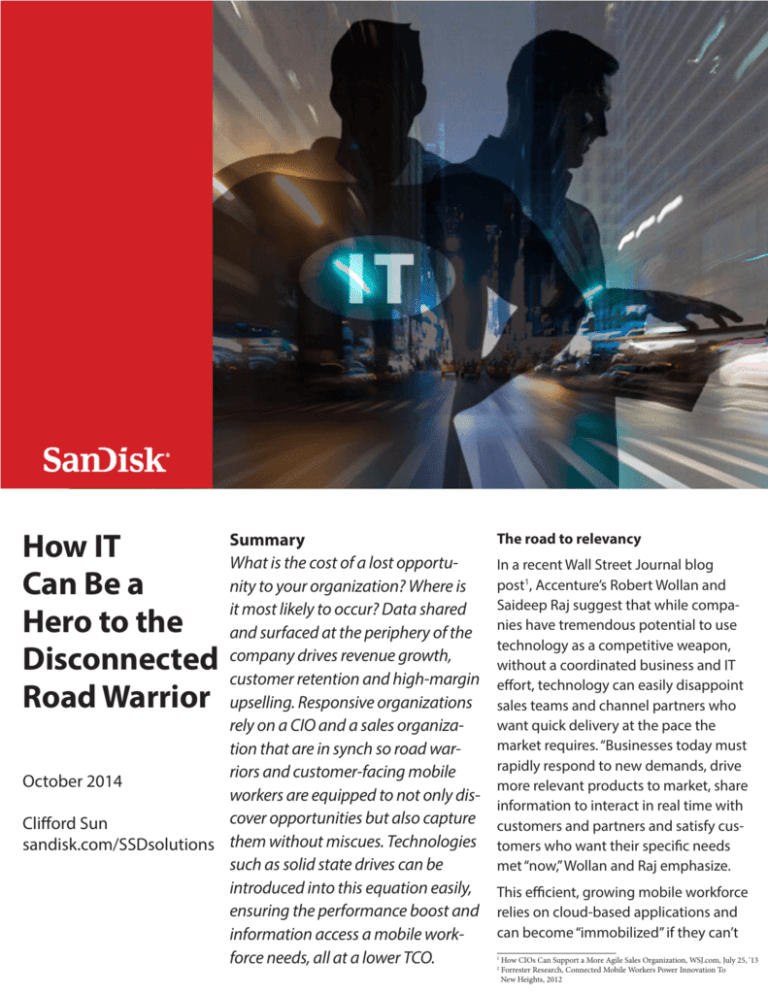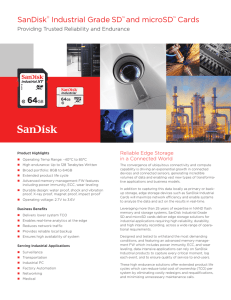
How IT
Can Be a
Hero to the
Disconnected
Road Warrior
Summary
What is the cost of a lost opportunity to your organization? Where is
it most likely to occur? Data shared
and surfaced at the periphery of the
company drives revenue growth,
customer retention and high-margin
upselling. Responsive organizations
rely on a CIO and a sales organization that are in synch so road warriors and customer-facing mobile
October 2014
workers are equipped to not only discover opportunities but also capture
Clifford Sun
sandisk.com/SSDsolutions them without miscues. Technologies
such as solid state drives can be
introduced into this equation easily,
ensuring the performance boost and
information access a mobile workforce needs, all at a lower TCO.
The road to relevancy
In a recent Wall Street Journal blog
post1, Accenture’s Robert Wollan and
Saideep Raj suggest that while companies have tremendous potential to use
technology as a competitive weapon,
without a coordinated business and IT
effort, technology can easily disappoint
sales teams and channel partners who
want quick delivery at the pace the
market requires. “Businesses today must
rapidly respond to new demands, drive
more relevant products to market, share
information to interact in real time with
customers and partners and satisfy customers who want their specific needs
met “now,” Wollan and Raj emphasize.
This efficient, growing mobile workforce
relies on cloud-based applications and
can become “immobilized” if they can’t
1
2
How CIOs Can Support a More Agile Sales Organization, WSJ.com, July 25, ’13
Forrester Research, Connected Mobile Workers Power Innovation To
New Heights, 2012
get online. What is the cost to collaboration if you can’t secure a signal? Does dependence on a shared cloud
drive that you can’t access jeopardize an important milestone? How does mobile benefit your organization if
you can’t service your customer onsite?
Let’s look at the four critical areas of sales-IT dependency: Mobile, Device, Connectivity and SaaS.
Mobile dependency
The clear benefits of mobility include improving productivity, enabling innovation to take place in real time
and reducing cycle times by enabling access to information and expertise across the company. And now
sales, supply chain operations and customer care personnel are often in the field much of the time as matter
of job function and efficiency.
Mobility has changed the workplace to such an extent that Forrester Research2 has identified a segment
called the “mobile information worker” — highly skilled consultants or executives who travel frequently but
must stay in touch with the office through e-mail and collaboration tools. Their work is more strategic than
tactical, thus potentially more valuable if achieved and more vulnerable if interrupted.
The goal of IT is to make things simple and seamless, so remote workers can easily engage in valuable communications and collaborative interactions that drive revenue and innovation. Leveraging tools and technologies that support redundancy and reliability (something as simple as solid state drives in laptops) helps a
mobile workforce improve performance and reduce the risks of the “always on” business world, even when
it isn’t always “online.”
Device dependency
The devices themselves limit the expected gains of mobility. It’s been said that a mobile device never malfunctions between 9 a.m. and 5 p.m., so there are the expenses that must be incurred to make up for the unreliability of hard-drive dependent laptops. Yet it goes beyond the personnel and capital costs to maintain a
24/7 help desk in anticipation of some percentage of failure. Operations can be crippled by a limited number
of laptops out of commission. Can a company afford even one out-of-touch laptop to delay mission-critical
product development, a service level agreement or a road show presentation for partners and analysts?
Forrester found that 52% of these information workers use three or more devices and 63% of those devices
are mobile — 25% are smartphones or tablets, 12% are netbooks and 26% are laptops3. Add to this complexity the work-life balance of sales teams and executives who drive business in multiple locations or on multiple continents simultaneously, with the expectation that they will be home and fully present for dinner, the
baseball game or the school play.
To limit device complexity from eroding productivity gains and cost savings, IT must lead by creating mobile
capabilities that deploy across lines of business and device types. Mobile device synchronization and efficiency should now be at the core of the IT strategy, not merely a tactical response or a task sitting in isolation
on the CIO’s to-do list. It’s about the performance consistency and reliability across all devices. In fact, Forrester’s Consumer Technographics® data shows that more than one-half of US online adults who begin tasks
on their mobile phone continue them on their laptop.4
Access dependency
What is the cost of a rescheduled sales call? With numerous dependencies and partners in today’s demand-driven supply chain, what are the implications when any one of the partners cannot join the conversation?
3
4
Forrester Research, Connected Mobile Workers Power Innovation To New Heights, 2012
http://blogs.forrester.com/category/laptops
Yet IT can’t always control Internet access for a company’s mobile workforce. The road warriors and the
hallway infantry are susceptible to any connectivity glitch or gap that puts them out of touch, if only for an
instant. Access to decision makers, subject matter experts and cross-functional collaborators is at a premium. They not only lose time, they lose momentum and possibly the attention of the customer or prospect in
front of them.
Connectivity has moved beyond the simple link between the device and the web; it’s now multi-faceted and
even more critical to rapidly changing opportunities and issue resolution. It can be difficult to satisfy customers if the remote mobile task worker is unable to access the Wi-Fi signal at the customer’s home or place
of business. Higher productivity and faster go-to-market cycles will not happen if just one or two members
of the team are unable to access a project timeline in the shared Google drive, or the videos needed to build
the sales presentation in Dropbox.
Responsive companies cannot afford protracted development or sales cycles, standard levels of customer
satisfaction and loyalty or a culture that’s not grounded in constant knowledge transfer. Winning organizations will leverage greater worker responsiveness and decision making, and that means speed and access
without limitation. The mobile workforce’s connectivity must be supplemented by access to offline tools and
best practices around local storage and cloud-drive mirroring by utilizing ubiquitous access solutions like
SSD in laptops.
SaaS dependency
It’s safe to say that IT has accepted Software as a Service (SaaS) enterprise-wide, and now, those early sales
adopters are primed for more sophisticated solutions and more customized, less out-of-the-box applications. Especially when those custom applications can be built quickly through agile development teams
instead of on capital budget timelines.
The proliferation and sophistication of these cloud apps and services cannot be denied, and increasingly
businesses of all sizes are looking to leverage their substantial benefits to support their mission critical operations. The question for IT teams is how to manage and assure always-on service levels and data security
when they don’t have the same control over cloud-based services that they have over on-premise applications.
Matthew Guay points out the obvious risk in his, “The Failure of the Cloud” blog: “As anyone who uses online
storage enough knows, free online storage won’t help anything…. Dropbox and Evernote – and most other
apps that use cloud storage – store everything on your computer as well as in the cloud. Everything takes up
space on your computer if you’re using native apps.”
Given the number and complexity of dependencies, it’s incumbent that the CIO not only support sales
activities with mobile infrastructure but also furnish the sales organization with lower-cost, higher-value,
faster-to-implement tools. These technologies must provide that broader sales ecosystem with faster access
to more relevant information and allow all parties and partners to engage in more meaningful ways. The
solution is a high-capacity SSD that mirrors the convenience of cloud storage while ensuring anytime, anywhere access, even without an Internet connection.
Conclusion
A responsive and technology-enabled sales organization must be collaborative, fast, rigorous and rich in key
analytics. The CIO understands that the sales ecosystem is broad by definition, ever expanding and less tolerant of delays.
5
http://web.appstorm.net/general/opinion/the-failure-of-the-cloud/
Today, it is not the lab assistant in the next office whose assistance we need, it’s the development team on
a distant continent, the field service technician traveling through rural hinterlands or the executive jetting
off to a global business center. There are also strategic partners and suppliers to consider. When the market
problems are complex and staggering, your value proposition must scale to address it.
The ability of an IT team to support a mobile workforce that uses multiple devices in multiple locations each
day is the differentiator. Local laptop storage capabilities, fast reboots and best practices like the mirroring
of shared drives, all accomplished by SSD, create the minute-by-minute consistency required to support
connectivity and collaboration. Let’s face it, there are going to be times when the Internet is not available
or specific Cloud apps are down beyond your control. When you have reliable and high performance local
storage such as SSDs in place, you’re truly supporting the entire organization with a full cloud solution.
The world of digital content grows exponentially every day and SanDisk is designing flash storage solutions so
that your valued data is readily available and reliable, even in the most challenging environments. SanDisk solid
state drives offer energy-efficient, compact and durable alternatives to traditional hard disk drives for desktops,
laptops and ultra-thin PCs.
©2014 SanDisk Corporation. All rights reserved. SanDisk is a trademark of SanDisk Corporation, registered in
the United States and other countries. Other brand names mentioned herein are for identification purposes
only and may be trademarks of their holder(s).








